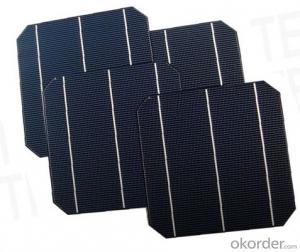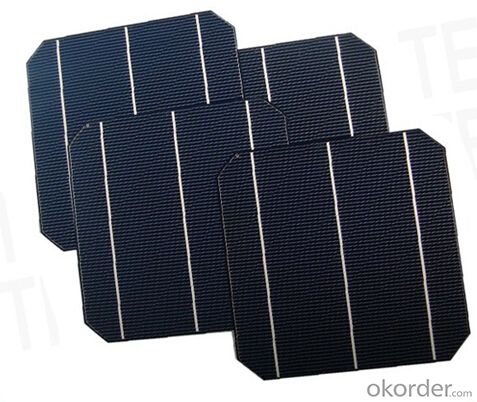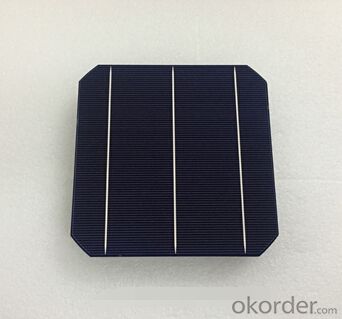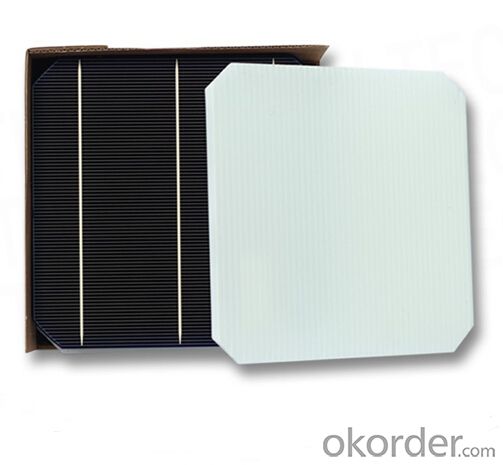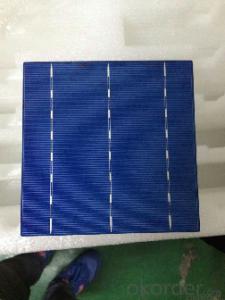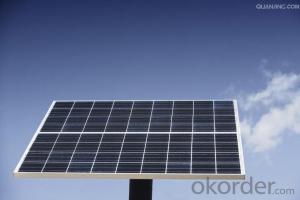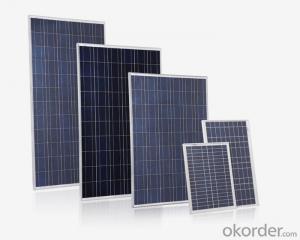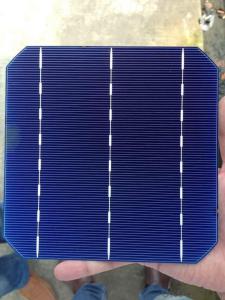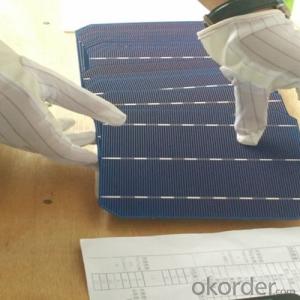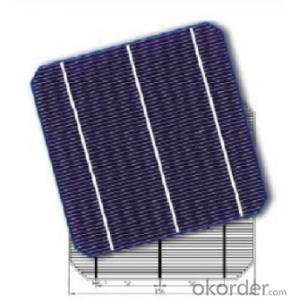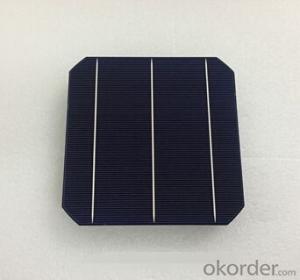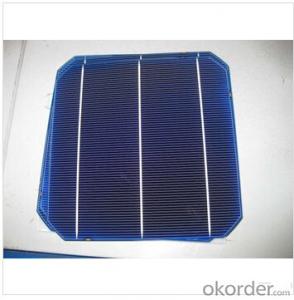Dye-Sensitised Monocrystalline 156 mm x 156 mm Solar Cells Supplier from China
- Loading Port:
- Shanghai
- Payment Terms:
- TT or LC
- Min Order Qty:
- 5000 pc
- Supply Capability:
- 80000 pc/month
OKorder Service Pledge
OKorder Financial Service
You Might Also Like
Brief Introduction of Solar Cells
A solar cell, is an electrical device that converts the energy of light directly into electricity by the photovoltaic effect, which is a physical and chemical phenomenon. It is a form of photoelectric cell, defined as a device whose electrical characteristics, such as current, voltage, or resistance, vary when exposed to light. Solar cells are the building blocks of photovoltaic modules, otherwise known as solar panels.
Advantage of Monocrystalline Solar Cells
• High efficiency and stable performance in photovoltaic conversion.
• Advanced diffusion technique ensuring the homogeneity of energy conversion efficiency of the cell.
• Advanced PECVD film forming, providing a dark blue silicon nitride anti-reflection film of homogenous color and attractive appearance.
• High quality metal paste for back surface and electrode, ensuring good conductivity, high pulling strength and ease of soldering.
• High precision patterning using screen printing, ensuring accurate busbar location for ease with automatic soldering a laser cutting.
Specifications of Monocrystalline Solar Cells
Format : 156 mm × 156 mm ± 0.5 mm
Thickness: 210 μm ±40 μm
Front (-) : 1.5mm bus bars (silver),blue anti-reflection coating (silicon nitride)
Back (+) : 2.5mm wide soldering pads (silver) back surface field (aluminium)
Efficiency (%) Pmpp (W) Umpp (V) Impp (A) Uoc (V) Isc (A) |
18.20% 4.43 0.536 8.263 0.634 8.712 |
18.00% 4.38 0.535 - 8.188 0.633 8.701 |
17.80% - 4.33 0.534 - -8.112 ---0.632 ----8.652 |
17.60% 4.28 0.533 8.036 0.631 8.641 |
17.40% 4.23 0.529 8.005 0.630 8.591 |
17.20% 4.19 0.525 7.973 0.627 8.542 |
17.00% 4.14 0.522 7.926 0.624 8.495 |
16.80% 4.09 0.518 7.893 0.620 8.452 |
16.60% 4.04 0.515 7.844 0.617 8.410 |
16.40% 3.99 0.514 7.765 0.616 8.373 |
16.20% 3.94 0.511 7.715 0.615 8.317 |
16.00% 3.89 0.509 7.650 0.613 8.251 |
Usage of Monocrystalline Solar Cells
Solar cells are often electrically connected and encapsulated as a module. Photovoltaic modules often have a sheet of glass on the front (sun up) side, allowing light to pass while protecting the semiconductor wafers from abrasion and impact due to wind-driven debris, rain, hail, etc. Solar cells are also usually connected in series in modules, creating an additive voltage. Connecting cells in parallel will yield a higher current; our solar cells have passed IEC Certification. With high and stable quality, our cells can greatly improve the performance of Solar Modules.
Packaging & Delivery of Monocrystalline Solar Cells
Carton Box Package and Deliver by air. It should be noticed that it should be avoid of water, sunshine and moist.
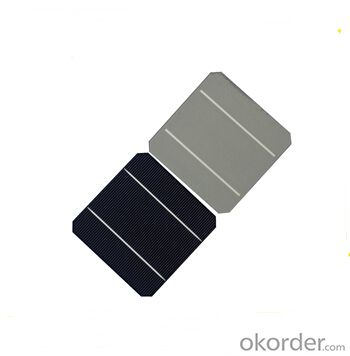
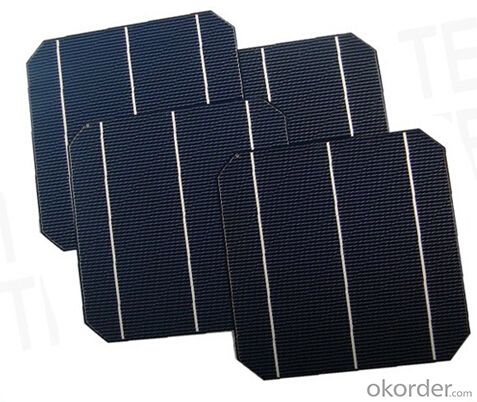
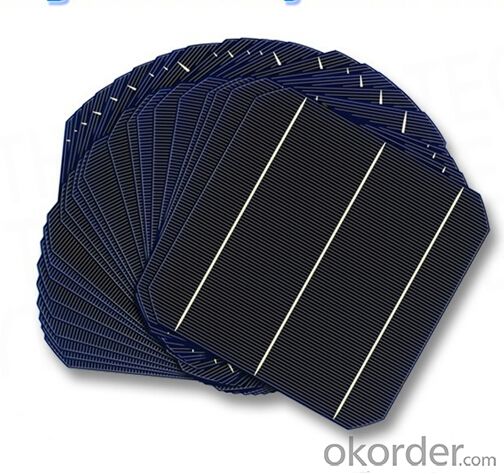
FAQ
We have organized several common questions for our clients,may help you sincerely:
①What price for each watt?
It depends on the efficiency of the solar cell, quantity, delivery date and payment terms.
②How long can we receive the product after purchase?
In the purchase of product within three working days, We will arrange the factory delivery as soon as possible. The pecific time of receiving is related to the state and position of customers.Commonly 7 to 10 working days can be served.
③Can you provide the peripheral products of the solar panels, such as the battery, controller, and inverter? If so, can you tell me how do they match each other?
Yes, we can, we have two companies for solar region, one is CNBM International, the other is CNBM engineering Co.
We can provide you not only the solar module but also the off grid solar system, we can also provide you service with on grid plant.
④What is your warranty of solar cell?
Our product can promise lower than 0.3% open box crack, we support claim after opening the box if it has crackm color difference or sth, the buyer should give pictures immediately, we can not accept the claim after the solar cell has assembled to solar panel.
• Timeliness of delivery
• ⑤How do you pack your products?
We have rich experience on how to pack the solar cell to make sure the safety on shipment, we could use wooden box or pallet as buyer's preference.
⑥ Can you do OEM for us?
Yes, we can.
Research direction of solar cell supplier
Now what solar cells suppliers are researching for? I think we all know the past few years, the photovoltaic industry in a slump, the reason that the industry cannot get rid of supporting policies is that the production costs are too high, so now all of them are desperately looking for a low-cost solar cell system, in the early stage of new materials or even tolerate its efficiency is very low. These low-cost battery can be attributed to the third generation of solar cells in the family, but also the story from 20 years ago talking about: the first line is the year Kodak has not closed down, a Chinese researcher found that organic dyes can also produce the photoelectric effect. Then European scholars dioxide nanoparticles staining, actually made an 8% efficiency solar cell chemistry, which is a dye-sensitized cells, 13% of the world record two years ago after the last time he climbed nature almost extinct from academia. The second line is a conductive organic Nobel Prize, we have to study photoelectric conversion, electric light switch or is organic led display, commercial very successful, who knows dynasty transfer power (that is, the solar cell) was actually a pit. But the Nobel laureate is still hopeful to open an organic photovoltaic company to give the Clinton administration's strong support; the result has been wiped out in order get the 2008 financial crisis. The battery has just broken the world record 10% of it. The third line is to make dye-sensitized cells found in the Japanese organic-inorganic hybrid material which can replace the perovskite structure of the dye, the efficiency of 3%. Europeans found that the material itself is a good photovoltaic semiconductor material, is now the world record by the Korean remained at 20%, last month issued a science. These three lines of batteries are the order of the temperature at room temperature with a chemical solution can be synthesized, lower cost than silicon cells, the question is not high enough efficiency lifetime is not long enough, but due to the relatively low barriers to entry (chemical laboratory on the line) Therefore worldwide research group particularly impact factor in the field have gone.
Now what solar cells suppliers are researching? Simply put, that is efficient and cost. Close to the production of research and development, the first is the original laboratory can efficiently process into mass production process, such as PERC, HIT, IBC, etc; more front-end development, is looking for more efficient and lower cost of battery cells materials, such as laminated battery, battery perovsk
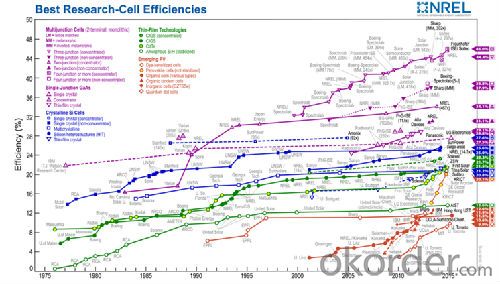
- Q: What is the difference between a solar cell and a solar panel?
- A solar cell is the basic unit that converts sunlight into electricity, while a solar panel is a collection of multiple solar cells arranged in a larger structure to generate a higher amount of electricity.
- Q: What is the role of junction boxes in solar cell systems?
- Junction boxes in solar cell systems serve as a crucial component for electrical connections and system protection. They are responsible for housing and safeguarding the electrical connections between solar panels, allowing the flow of electricity to and from the panels. Additionally, junction boxes play a vital role in preventing damage from environmental factors such as moisture, dust, and excessive heat.
- Q: How do solar cells handle hail or other physical damage?
- Solar cells are designed to be durable and withstand various weather conditions, including hail or physical damage. The cells are typically made of tempered glass, which is highly resistant to impact. Additionally, solar panels are tested and certified to meet certain industry standards for hail resistance. In the event of severe damage, such as a shattered panel, individual cells can be replaced without affecting the overall performance of the solar system.
- Q: What is the impact of dust and dirt on solar cell efficiency?
- Dust and dirt can significantly reduce the efficiency of solar cells. When dust accumulates on the surface of solar panels, it creates a barrier that inhibits the penetration of sunlight, thereby reducing the amount of energy that can be converted into electricity. Additionally, dirt particles can cause shading effects and create hotspots, which further decrease the overall efficiency of the solar cells. Regular cleaning and maintenance of solar panels are crucial to keep them operating at their maximum potential.
- Q: Can solar cells be used in remote sensing applications?
- Yes, solar cells can be used in remote sensing applications. Solar cells are capable of converting sunlight into electrical energy, which can power various remote sensing instruments and devices. This enables the collection of data and information from remote areas where conventional power sources may not be readily available. Solar-powered remote sensing systems are widely used in applications such as weather monitoring, environmental monitoring, agriculture, and surveillance, among others.
- Q: How do solar cells impact job creation?
- Solar cells have a positive impact on job creation as they require a skilled workforce for the manufacturing, installation, and maintenance of solar panels. The growing demand for solar energy has created various job opportunities in sectors such as engineering, construction, and clean energy technology, thus contributing to economic growth and employment opportunities.
- Q: How do solar cells compare to fossil fuels in terms of energy production?
- Solar cells have several advantages over fossil fuels in terms of energy production. Firstly, solar cells harness renewable energy from the sun, while fossil fuels are non-renewable and finite resources. Secondly, solar cells produce clean energy, emitting no greenhouse gases or pollutants, whereas fossil fuels release harmful emissions that contribute to climate change and air pollution. Additionally, solar cells can be installed on rooftops or in remote areas, making energy production more decentralized and less reliant on centralized power plants. However, solar cells currently have limitations in terms of efficiency and storage capacity, which fossil fuels have a higher energy density and can provide continuous power supply. Overall, solar cells offer a sustainable and environmentally-friendly alternative to fossil fuels, but further advancements are needed to fully replace their energy production capabilities.
- Q: Can solar cells be used for powering electric gates?
- Yes, solar cells can be used to power electric gates. Solar cells convert sunlight into electricity, which can be stored in batteries or directly used to power various devices. By installing solar panels near the gate, the generated electricity can be utilized to operate and control electric gates, providing a sustainable and reliable source of power.
- Q: Can solar cells be used in public transportation?
- Yes, solar cells can be used in public transportation. Solar panels can be installed on the roofs of buses, trains, and trams to generate electricity from sunlight. This renewable energy can be used to power various systems in public transportation, such as lighting, air conditioning, and even charging onboard devices. Additionally, solar cells can also be used to charge electric vehicles used in public transportation, reducing reliance on fossil fuels and contributing to a more sustainable transportation system.
- Q: Can solar cells be used for powering outdoor signage?
- Yes, solar cells can be used for powering outdoor signage. Solar panels can convert sunlight into electricity, which can then be used to power various devices including outdoor signage. This is a sustainable and environmentally friendly option, as it reduces dependence on traditional electricity sources and helps to minimize carbon emissions.
Send your message to us
Dye-Sensitised Monocrystalline 156 mm x 156 mm Solar Cells Supplier from China
- Loading Port:
- Shanghai
- Payment Terms:
- TT or LC
- Min Order Qty:
- 5000 pc
- Supply Capability:
- 80000 pc/month
OKorder Service Pledge
OKorder Financial Service
Similar products
Hot products
Hot Searches
Related keywords
